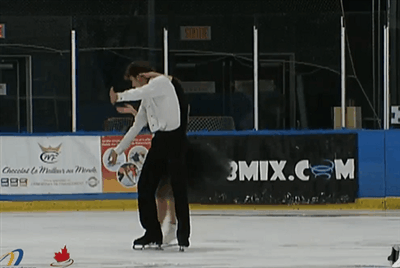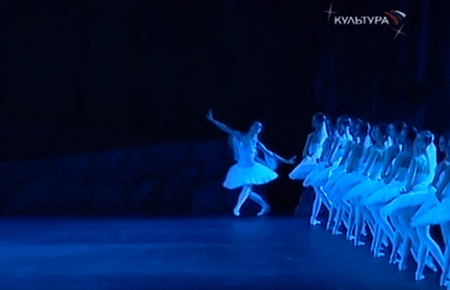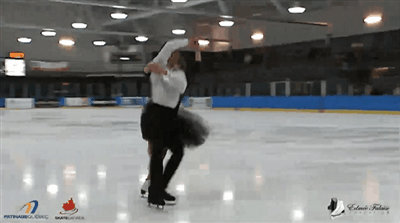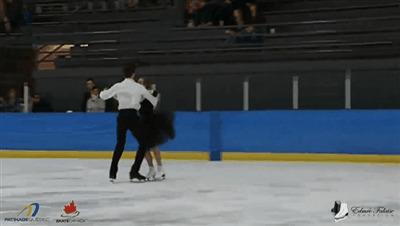by Jacquelyn Thayer
Taking on a Ravensburger Waltz with a classical ballet twist was a task Alexandra Paul and Mitch Islam were loath to take lightly.
“Any time you tackle a new program, there are countless hours that go into researching, choreographing and perfecting the style of movement,” said Islam. “With a world-renowned style like ballet, you have to make sure you really nail it.”
“Ballet is a very technical form of art and with that come some challenges,” said Paul. “There are strict rules that you have to abide by when studying and performing ballet, and that’s what we’re trying to bring to the ice.”
Between Paul’s extensive off-ice studies in the discipline and Islam’s own years of training, it was also a challenge of their own making. “We knew from the beginning that we wanted to do a ballet-centric program,” said Paul.
But concept demands music — and conventional selections like Giselle or Swan Lake held limited interest. “It took us a little longer than we had planned to find music for our short this year,” said Paul. “When we came across the Tales of Beatrix Potter 1 music [“The Mouse Waltz” and “The Tale of Squirrel Nutkin“] on iTunes after looking tirelessly for original music that could be used for a ballet-themed piece, we knew we’d found something interesting. It is certainly unique and that’s one of the reasons we’re enjoying it so much.”
“It’s always a good feeling when you find a piece of music that you love that you’ve never heard before,” agreed Islam. “On top of that, there is so much character within this music. It calls for so much personality and that’s something we’re embracing as the program evolves.”
The first step settled, the team, recently relocated to Montreal’s Gadbois Centre training base, turned to creation. New coach Romain Haguenauer, who in the team’s early days at the Mariposa School of Skating choreographed for them a flamenco original dance and sleek rumba short dance, took the reins.
“Once we had decided on our music for the program, we totally entrusted Romain with the choreography and layout,” said Islam. “In working with him before, we knew how creative he is as a choreographer and we were excited to see what he’d come up with for this piece.”
Also key to the program’s development have been two members of Gadbois’s off-ice staff: ballet instructor Daria Kruszel and performance coach Catherine Pinard. Pinard has helped the couple develop the program’s story — one still in progress. “I can say the program is about a dream I’m having and it involves my fascination with a ballet dancer,” said Islam.
Though primarily a technical advisor, Kruszel has offered some creative input. “I do allow myself to take the liberty of making suggestions, and working out small sections of movement for them to try out on the ice, for the approval of their on-ice coaches,” she said. “However, some balletic movement that would look absolutely right in studio, or in a theatre setting on stage, doesn’t always translate well to the immense expanse of white that is the ice. So some of it gets kept, and some doesn’t, and that’s perfectly okay.”
“The name of the game is continuous improvement and growth, and for the sake of the dancers — I still call them dancers, even if they’re athletes first and foremost — there is no room for ego in regards to choreography. If it works it works. If it doesn’t, move on,” she concluded.
The finer points of movement have been central to the team’s focus — eased by a strong comfort level for both. “With several years of ballet experience, this program is coming quicker than programs in the past where it takes more time to master the particular style that may be a bit more foreign to me,” noted Islam, while Paul considers the form “somewhat second nature.”
Kruszel has supplemented her twice-weekly off-ice classes with program-specific guidance.
“The work Alex, Mitch and I have put in is mostly to refine the classical arm positions, which are so important in such a classically-based piece as their short program,” she said. “In ballet, right is right, and ‘almost’ just isn’t good enough. So it’s very important to all the coaching staff that we get it as close to perfect as possible. Luckily, with their previous ballet training having been so comprehensive, their understanding of the positions required and the muscle memory to make it happen consistently is already in place, which is a blessing for any ballet teacher.”
Like any traditional dance style, its elemental demands — designed for floor — are vastly removed from what may be physically possible on the ice. Though utilization of ballet’s port de bras and posture has a long tradition in skating, footwork presents very different concerns.
“Some of the specific difficulties include going on pointe,” said Paul. “On skates you can’t go up on full pointe or balance on your toe-picks in a proper ballet position, so we’ve had to adapt some of the movements.”
And Kruszel highlighted a particularly challenging sequence.
“There is a lovely section of their choreography that includes two particular ballet steps, temps levé and cabriole, that while they were initially choreographed on ice, are devilishly hard to get quite right,” she said.
“Normally, in ballet, the temps levé would be a traveling step and the cabriole a jump from two feet where the legs beat in the air. Here Mitch is lifting Alex face to face in a rotational movement so she hasn’t the push forward for the temps levé or the brushing movement of the feet for the cabriole that we would normally use for the force to get off the floor — not to mention, of course, that they haven’t a floor to begin with, rather it’s ice, and that just ups the game that much more.”
The couple’s focus ahead of this week’s Nebelhorn Trophy, their first international of the season, is standard — improving Ravensburger Waltz levels (after receiving Levels 1 and 4 in their debut at August’s Quebec Summer Championships) along with speed and strength. “We have also been working on adding more character to the program as a whole, to show the change in rhythms and emotions throughout,” said Paul.
And as for choreographic technique, their ballet instructor has particular confidence.
“As for movements that could be considered easy to transfer onto skates, when you have such gifted dancers as Alex and Mitch with such wonderful training, they’re already one step ahead physically to make the transition,” said Kruszel. “Somehow, they make it look so easy, even on the first run.”




